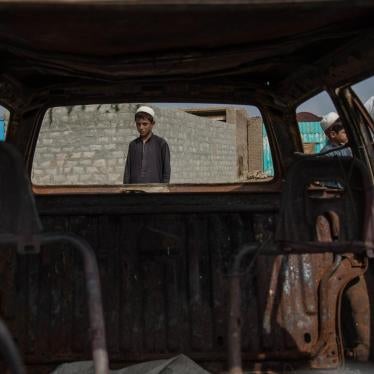Dear President Obama,
We write to ask that your administration provide greater clarity about its legal rationale for targeted killings, including the use of Unmanned Combat Aircraft Systems (drones), and the procedural safeguards it is taking to minimize harm to civilians.
US history shows that once such a program is initiated, even if in response to a specific contingency like the threat posed by al Qaeda in Yemen, it generally becomes a permanent feature of the national security landscape. You will not be the last US president to claim the authority to conduct such strikes. And the United States is not the only country in the world with the ability and motivation to kill its enemies beyond its borders. While such operations may be lawful under certain circumstances, absent clear boundaries they risk setting an example that any US president-and the leader of any other country-could cite to evade the most fundamental legal restrictions on the power to kill.
Your administration has dramatically expanded the use of targeted killings outside of traditional battlefields following the attacks of September 11, 2001. The US government asserts that it has authority under international law to use lethal force outside of clearly defined war zones because it is engaged in a global armed conflict with al-Qaeda and associated forces.
A US district court judge's dismissal today of a targeted killings lawsuit on jurisdictional grounds highlights the need for the Obama administration to publicly clarify its position on this issue. As Judge John Bates of the district court in the District of Columbia noted in his dismissal, the merits of the case, which he said raise "vital considerations of national security and of military and foreign affairs," as well as "fundamental questions of separation of powers," remain unaddressed.
Human Rights Watch recognizes that the US government has a responsibility to respond to national security threats. We recognize that the deliberate use of lethal force can be legal in operations involving a combatant on a genuine battlefield, or in a law enforcement action in which the threat to life is imminent and there is no reasonable alternative. We also recognize the challenge that your government faces in trying to address potential threats that are not in a traditional conflict zone yet are also beyond the reach of any law enforcement. The notion, however, that the entire world is a battleground in which the laws of war are applicable undermines the protections of international law. Such a concept invites the application of lethal force by other countries in situations where the US would strongly object to its use.
In March 2010, State Department legal advisor Harold Koh took a step in the right direction by explaining the US government's targeted killing program in general terms and affirming its commitment to conduct these strikes in accordance with international law and the Constitution. The administration, however, has not yet clearly explained where it draws the line between lawful and unlawful targeted killings. We believe that it is both its obligation and in its self-interest to do so.
With these concerns in mind, we offer the following detailed recommendations:
Do not define all operations as part of a "global armed conflict"
Whether or not a targeted killing is legal under international law depends, in part, on the whether it is carried out in the context of an armed conflict. In justifying its combat operations outside of traditional war zones, US officials have asserted that the United States is engaged in a global armed conflict with al Qaeda, the Taliban, and vaguely defined "associated forces" and is exercising its inherent right to self-defense.
While the United States is a party to armed conflicts in Afghanistan and Iraq and could become a party to armed conflicts elsewhere, the notion that the entire world is automatically by extension a battleground in which the laws of war are applicable is contrary to international law. How does the administration define the "global battlefield" and what is the legal basis for that definition? What, if any, limits exist on ordering targeted killings within it? Does it view the battlefield as global in a literal sense, allowing lethal force to be used, in accordance with the laws of war, against a suspected terrorist in an apartment in Paris, a shopping mall in London, or a bus station in Iowa City? Do the rules governing targeted killing vary from one place to another-for example, are different criteria used in Yemen and Pakistan?
Define who may be legally targeted
We are also concerned about US practices that may seek to expand the category of who may legally be targeted and under what conditions. What process is used to determine whether a person may be targeted for killing rather than afforded due process? Legal advisor Koh has emphasized that the decision to target someone for killing outside traditional combat zones depends on "considerations specific to each case," as well as the "imminence of the threat," but how does your administration define these terms? Must the target be planning an armed attack, or is it sufficient to be a likely participant? Can an individual be targeted solely for past acts, absent specific evidence of involvement in planning future attacks? Are the standards for targeting US citizens-for example American cleric Anwar al-Awlaki, who is hiding in Yemen-the same as for individuals of other nationalities? How does your administration define "associated forces" that may be targeted and how does it measure their support for groups such as al Qaeda?
Ensure compliance with the laws of war
As the US acknowledges, even targeted killings within conflict zones must be carried out in compliance with the laws of war, including the requirements of distinction and proportionality. During armed conflict, only combatants or civilians who are directly or actively participating in hostilities may be lawfully targeted. The killings must be of military necessity, the expected military gain must outweigh anticipated harm to civilians and civilian objects, and all feasible measures must be taken to minimize civilian harm. The US government states that "great care" has been taken to adhere to these principles, but it has not provided sufficient information on its targeting decisions thus far to allow an impartial determination as to whether these requirements have been met. For example, it has not explained how it designates targets as militants or measures proportionality in areas such as northwest Pakistan, where the CIA has reportedly conducted more than 120 drone strikes that have killed more than 800 people, including an unknown number of civilians.
Ensure compliance with international human rights law
International human rights law permits the use of lethal force outside of zones of armed conflict if it is strictly and directly necessary to save life. In particular, the use of lethal force is lawful if the targeted individual presents an imminent threat to life and less extreme means, such as capture or non-lethal incapacitation, are insufficient to address that threat. For strikes outside of conflict zones, the US should fully explain the clear and imminent threat to life that the targeted individual represents and the circumstances that prevented less-than-lethal force from being applied. Even in combat zones, it may in some circumstances be prudent for the US to attempt to capture rather than to kill a legitimate target-not only to gain intelligence, but also to delegitimize terrorists as criminals rather than elevating them to the status of warriors.
Improve transparency and accountability
The US has in part refused to fully define the legal limits of its targeted killing program by citing the need to keep sensitive national security information secret. Your administration has been particularly reticent to disclose details of targeted killings by the CIA drone strikes in northwest Pakistan. However, providing a fuller explanation would not require the US to divulge information of operational value. It would simply help establish that this administration recognizes that there are legal limits on its actions and good strategic reasons to embrace those limits.
The information we would urge your administration to make public includes: How many people are estimated to have been killed in US targeted killings since 2001? In which countries have the killings occurred? How many of these people are believed to have been civilians? What differences, if any, do the CIA and Defense Department apply in making targeting decisions? What kind of review is conducted after a targeted killing? (The Israeli Supreme Court, in an important ruling on targeted killings, in 2006 instructed Israeli forces to carry out a thorough and independent investigation in the wake of every such killing.) If a targeted killing violated international law, what mechanisms exist to investigate and if necessary discipline or prosecute those responsible? What measures have been taken to hold accountable military personnel, CIA officers, and private contractors for targeted killings that violated international law?
Minimize harm to civilians
Even lawful drone strikes can alienate populations and hand insurgents a propaganda tool if they result in high civilian casualties. The US military learned that lesson the hard way in Afghanistan, where its July 2009 tactical directive regarding civilian protection sounds an important cautionary note: "We must avoid the trap of winning tactical victories-but suffering strategic defeats-by causing civilian casualties or excessive damage and thus alienating the people." It is witnessing a similar backlash today in Pakistan and Yemen.
This lesson acquires further importance as the US contemplates expansions of its drone program to kill targeted militants. When used appropriately, drones offer certain advantages over manned aircraft or cruise missiles that can help the military minimize civilian casualties in combat operations. Because of drones' enhanced surveillance capabilities, drone operators are better equipped to distinguish between combatants and individuals directly participating in hostilities-persons who can be legitimately targeted during armed conflict-and civilians who are immune from attack.
Nevertheless, the ability of US forces to direct drones with surgical precision in areas outside traditional battlefields may be hampered by a lack of ground presence, increasing the risk of poor intelligence and of local actors manipulating international forces.
Because of the inherent difficulty in measuring proportionality in such areas, we urge that the US government use all the resources at its disposal to make not only pre-strike but also post-strike assessments of civilian harm, factor those assessments into planning for future strikes, and publicly acknowledge responsibility for harm when it occurs.
The United States also should provide timely and adequate compensation to all civilian victims of drone strikes or other targeted killings, even if the harm incurred is legally justified, just as it does when US forces inadvertently kill civilians in conflict areas such as Afghanistan or Iraq.
Avoid dangerous precedents
In asserting that targeted attacks on alleged terrorists anywhere in the world are lawful, the US undermines the international rules it helped craft over the past half-century that bar extrajudicial executions. This sets a dangerous precedent for abusive regimes around the globe to conduct drone attacks or other strikes against persons who they describe in vague or overly broad terms as terrorists-and undercuts the ability of the US to criticize such attacks.
Could China lawfully declare an ethnic Uighur activist living in New York a "terrorist" and, if the US were unwilling to extradite that person, order a lethal strike on US soil? Could Russia lawfully poison to death someone living in London whom they claim is linked to Chechen militants? Clearly, the United States would oppose such actions. But the administration has not laid out a legal rationale for drone strikes or other deliberate uses of lethal force in countries such as Yemen and Pakistan that would distinguish them from targeted killings that reasonable people would consider unlawful. The US should not carry out a lethal strike if it would object to another country conducting such a strike under similar circumstances and a similar rationale.
In conclusion, Mr. President, your targeted killing policy will have profound ramifications for future commanders-in-chief in both the US and other countries for years to come. Governments' coercive power, especially the awesome power to deprive people of liberty and life, must be exercised within limits defined by laws that protect due process and human rights. Only by acting in accordance with those limits will the US set an example for the rest of the world.
You yourself reaffirmed this notion when you accepted the Nobel Peace Prize. "Even as we confront a vicious adversary that abides by no rules ... the United States of America must remain a standard bearer in the conduct of war," you noted. "That is what makes us different from those whom we fight. That is the source of our strength." With this letter, we ask that you provide the legal framework to uphold these words.
Thank you for your attention to this important matter. We would be happy to provide additional information on any of the issues noted in this letter.
Sincerely,
Kenneth Roth
Cc: Secretary of State Clinton
Secretary of Defense Gates
CIA Director Panetta







